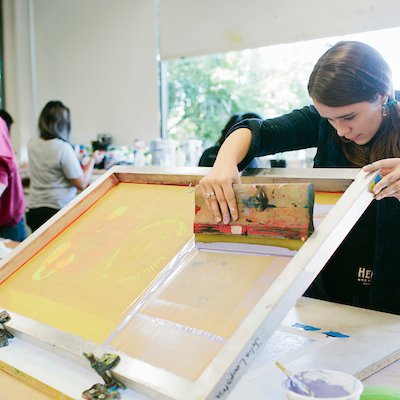The Important Guide to Comprehending Screen Printing and Its Versatile Uses
Screen printing has an abundant history that dates back to ancient times, developing right into an innovative technique made use of across numerous industries today. This guide discovers the complexities of the screen printing procedure, outlining its applications in style, advertising, and home décor - 10:9 Design contact. Understanding these principles can open up imaginative capacity for both commercial and creative jobs. The complying with areas will certainly expose crucial pointers and methods to enhance one's screen printing ventures
The Background of Screen Printing
Although screen printing has roots that trace back centuries, its development reflects the imaginative and technical advancements of various societies. Originating in old China, the technique was at first used for enhancing fabrics and later spread to Japan, where it became important to Ukiyo-e woodblock printing. The approach shifted to Europe in the 18th century, where it gained popularity among artisans and industrial printers. The innovation of photo solution in the 20th century transformed screen printing, permitting more complex layouts and better effectiveness. Artists like Andy Warhol further propelled its popularity, using the medium to create iconic jobs that mixed commercialism and great art. By the late 20th century, screen printing had actually established itself as a functional strategy, employed in fashion, advertising and marketing, and great art. Today, it continues to progress, incorporating digital modern technology and broadening its applications across numerous sectors.
The Screen Printing Refine Explained
Screen printing changes artistic visions into tangible designs through a series of specific steps. An image is developed and then moved onto a screen, normally made of great mesh material stretched over a structure. A light-sensitive solution is put on the screen, which is subjected to light, hardening in locations not covered by the picture. After cleaning out the unhardened solution, a pattern is formed.
Next off, the screen is positioned over the substratum, whether it be fabric, paper, or one more material. Ink is then pushed via the open areas of the stencil making use of a squeegee, depositing the style onto the substratum listed below. This procedure can be duplicated for several colors, needing different displays for every shade. Finally, the published thing is treated utilizing heat to assure the ink sticks appropriately, causing a sturdy, lively layout on-line.
Kinds of Screen Printing Techniques

Additionally, specialty methods, such as discharge screen printing, remove color from the textile to develop softer prints, while aluminum foil screen printing uses metallic foil to achieve a shiny finish (10:9 Design contact). Each strategy offers distinct features, satisfying numerous innovative needs and production scales, inevitably broadening the opportunities within the screen printing domain
Applications of Screen Printing in Numerous Industries

Additionally, the signage and marketing fields use screen printing for creating attractive screens and banners. This approach enables bold colors and complex styles that capture attention. In electronic devices, screen printing is employed for using conductive inks to circuit boards, essential for part links. In addition, the home décor industry accepts screen printing to generate distinct designs on fabrics and wall surface art. Overall, screen printing functions as an important tool across diverse fields, enhancing products with individualized and visually attractive graphics.
Tips for Effective Screen Printing Projects
While embarking on a screen printing task, cautious focus to detail can considerably improve the last end result. Choosing high-quality materials is necessary; this includes the screen, inks, and substrates. Utilizing proper mesh counts can influence ink deposition and detail resolution. Prep work is similarly important; extensive cleansing of displays and correct exposure times assure crisp prints.
Next, accurate registration is vital for multi-color prints. Utilizing positioning tools can aid accomplish accurate layering. Furthermore, testing prints Learn More on scrap materials prior to production assists identify possible problems without wasting sources.

Regularly Asked Concerns
What Products Are Finest for Screen Printing on Fabric?
Cotton and polyester blends are excellent for screen printing on material as a result of their toughness and ink absorption. Furthermore, specialty fabrics like silk or canvas can produce distinct appearances and finishes, boosting the overall design quality.
Just how Do I Clean and Maintain Screen Printing Devices?
To cleanse and maintain screen printing devices, one should frequently clean screens with appropriate solvents, inspect mops for wear, lube moving parts, and store all items in a completely dry, dust-free setting to lengthen their life expectancy.
What Are the Ecological Impacts of Screen Printing?
Screen printing can have significant ecological impacts, consisting of chemical waste from inks and solvents, water usage during cleaning processes, and energy intake. Sustainable techniques and green products are vital for minimizing these adverse results.
Can Screen Printing Be Done in the house Efficiently?
Screen printing can be properly done at home with the appropriate materials and techniques. Hobbyists can create top quality prints, though success relies on their skill degree, tools, and understanding of the procedure involved.
What Are the Prices Related To Starting a Display Printing Service?

Starting a screen printing service involves prices for devices, products, and work space. First expenditures typically vary from a couple of hundred to a number of thousand dollars, depending on the range, Go Here high quality of machinery, and wanted production ability.
Screen printing has a rich history that dates back to ancient times, advancing into an advanced strategy utilized across various industries today. Another strategy, rotary screen printing, uses cylindrical screens, helping with continuous printing on material rolls, thus improving efficiency for large-scale productions. Additionally, specialty methods, such as discharge screen printing, remove dye from the textile to produce softer prints, while foil screen printing applies metallic foil to accomplish a glossy surface. In the fashion sector, screen printing is extensively utilized to develop lively designs on apparel, enabling brand names to showcase their special designs. Cotton and polyester blends are suitable for screen printing on fabric due to their toughness and ink absorption.